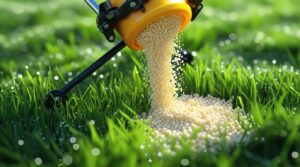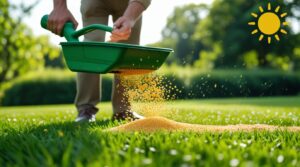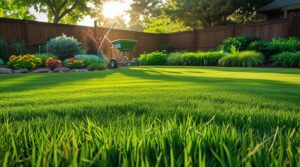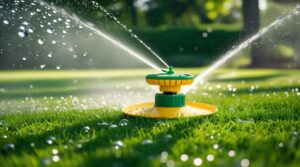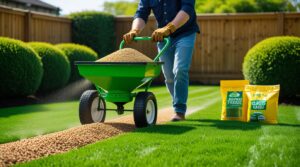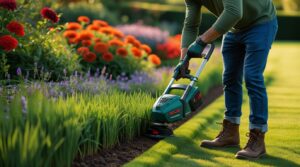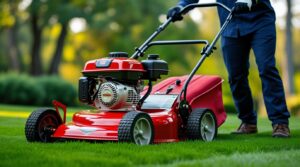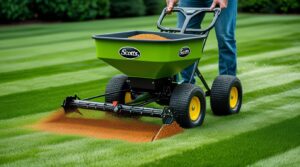Is your lawn looking dry and tired, no matter how much you water it? You’re not alone. Many homeowners put in the time and effort, yet still struggle with patchy grass, brown spots, and a lawn that just won’t thrive. The truth is, lawn watering isn’t just about turning on the hose and hoping for the best — it’s a science.
In fact, improper watering can damage your lawn more than skipping it altogether. Overwatering can drown roots and invite fungus, while underwatering can leave your grass dry, brittle, and lifeless. The good news? It doesn’t have to be this way.
In this complete guide to lawn watering, we’ll show you everything you need to know — from the perfect time of day to water, to how much water your lawn really needs, plus the best tools to do the job efficiently. Whether you’re a first-time homeowner or a seasoned lawn care enthusiast, this guide will help you water smarter, not harder, and finally get that lush green lawn you’ve been dreaming of.
Why Proper Lawn Watering Is Crucial
Think watering your lawn is just about keeping it green on the surface? Think again. Proper lawn watering goes far beyond aesthetics — it plays a vital role in the overall health and longevity of your turf.
When done right, lawn watering encourages deep root growth, making your grass more resilient against heat waves and drought. Deep roots help your lawn access moisture stored deeper in the soil, which means you won’t need to water as frequently, saving you time and effort in the long run.
It also plays a key role in disease prevention. Overwatering or watering at the wrong time of day creates a moist environment that’s perfect for mold, mildew, and fungus. These issues often lead to yellowing patches or even full-blown lawn rot, and nobody wants that.
And let’s not forget the practical benefits. Smart lawn watering habits can reduce water usage by hundreds, even thousands, of gallons each season, which translates to lower utility bills and a more eco-friendly home.
Best Time to Water Lawn
Timing is everything when it comes to lawn watering, and getting it wrong can mean wasting water — and worse, damaging your grass.
- Early morning is hands-down the best time to water your lawn, ideally between 4 a.m. and 10 a.m. Why? Because temperatures are cooler and winds are calm, allowing water to soak deep into the soil before the sun has a chance to evaporate it. Morning watering also gives your lawn time to dry out gradually throughout the day, reducing the risk of fungal growth.
- Nighttime watering, on the other hand, is one of the biggest mistakes homeowners make. When you water in the evening, moisture sits on the grass blades overnight. This creates a breeding ground for diseases like dollar spot, brown patch, and other fungal infections that thrive in damp conditions.
- Afternoon watering might seem convenient, but it’s often the least effective. The midday sun speeds up evaporation, meaning much of your water disappears before it can reach the roots. In extreme heat, it can even scorch your lawn.
How Much Water Does Your Lawn Need?
One of the most common questions in lawn watering is, “How much is enough?” The answer might surprise you — most lawns only need about 1 to 1.5 inches of water per week, and that includes rainfall.
That’s right — overwatering can be just as harmful as underwatering. To avoid waste and root rot, it’s important to measure how much water your lawn is getting. A simple way is the “tuna can test”: Place a few empty cans around your lawn and run your sprinkler. When the water in the cans reaches about 1 inch, you’ve hit your goal.
You can also use a rain gauge or soil probe to track moisture more accurately, especially if you’re using a smart irrigation system.
Factors That Affect Lawn Watering Needs:
- Soil Type: Sandy soil drains faster and may require more frequent watering. Clay holds water longer, but is prone to runoff.
- Grass Type: Cool-season grasses like fescue need more water than warm-season varieties like Bermuda.
- Slope & Sun Exposure: Lawns on slopes or in full sun may dry out faster and need slightly more attention.
Weekly Water Needs by Grass Type
| Grass Type | Water Needs per Week |
| Kentucky Bluegrass | 1.5 inches |
| Tall Fescue | 1.0–1.25 inches |
| Bermuda Grass | 1.0 inch |
| Zoysia Grass | 0.75–1.0 inch |
| Perennial Ryegrass | 1.25–1.5 inches |
Knowing your lawn’s specific needs helps avoid both waste and stress, making your lawn watering routine more efficient and effective.
Signs You’re Watering Too Much or Too Little
Even with the best intentions, many people get lawn watering wrong without even realizing it. Knowing the signs of overwatering and underwatering can help you adjust before your lawn suffers permanent damage.
Too Much Water?
If your lawn feels spongy or mushy when you walk on it, that’s a red flag. Overwatered lawns are also prone to mushroom growth, and you might notice yellowing grass, a sign that the roots are drowning and not getting enough oxygen.
Too Little Water?
On the flip side, a thirsty lawn will show footprints that don’t spring back, curling grass blades, and dry or cracked soil. If your lawn has a dull blue-gray tint instead of a healthy green, it’s crying out for moisture.
Pro Tip:
Stick a screwdriver straight into the soil. If it goes in easily, your lawn is well-hydrated. If it’s difficult to push in, your lawn is too dry and needs a proper lawn watering session.
Learning to spot these early signs helps you strike the perfect balance, keeping your lawn lush without wasting a single drop.
Watering Methods & Tools
When it comes to lawn watering, the method you use can be just as important as how often you do it. The right tools not only make watering easier but also ensure water is distributed evenly and efficiently, which means a healthier lawn and lower water bills.
Sprinkler Types
Sprinklers are essential tools for maintaining a healthy lawn or garden by ensuring consistent and efficient watering. There are several types of sprinklers available, each designed for different lawn sizes, shapes, and watering needs. From simple fixed models for small gardens to smart systems that adjust to weather conditions, choosing the right sprinkler can make a big difference in water efficiency and plant health.
Sprinklers generally fall into the following main categories:
Oscillating Sprinkler
An oscillating sprinkler is a type of lawn or garden sprinkler that distributes water in a fan-shaped pattern by moving back and forth (oscillating). It’s one of the most popular and effective sprinkler types for evenly watering rectangular or square-shaped areas like lawns or garden beds.
How Oscillating Sprinklers Work:
-
They use a tube with multiple holes (jets) that spray water.
-
The tube moves side to side in an arc motion.
-
Water is pushed through under pressure, covering a wide area with a “wave” of water.
Advantages:
-
Even Water Distribution – Ideal for large, flat lawns.
-
Adjustable Coverage – You can adjust the width, range, and pattern of the spray.
-
Gentle Watering – Suitable for delicate plants and new grass.
-
Kid-Friendly – Often used as a fun water toy for children in summer!
Disadvantages:
-
Wind Sensitive – Spray can be disrupted by strong winds.
-
Clogging Risk – Jet holes can get clogged if water is hard (mineral-rich).
-
Not Ideal for Uneven Terrain – Works best on flat surfaces.
Rotary Sprinkler
A rotary sprinkler is a type of lawn sprinkler that sprays water by rotating in a circular or semi-circular motion. Unlike oscillating sprinklers (which fan water back and forth), rotary sprinklers spin to deliver streams of water, often at a slower, more targeted rate—ideal for deeper soil penetration.
How Rotary Sprinklers Work:
-
They feature spinning arms or rotating nozzles powered by water pressure.
-
As water flows through, it creates motion that spins the sprinkler head.
-
They typically shoot water in a circular pattern, either full-circle or part-circle.
Advantages:
-
Efficient Water Use – Slower output allows water to soak in and reduces runoff.
-
Great Coverage for Large Lawns – Many models can spray up to 50+ feet.
-
Durable Design – Often built for long-term use with fewer moving parts.
-
Wind Resistant – The water streams are thicker and less affected by wind.
Disadvantages:
-
Uneven Coverage in Tight Spaces – Not ideal for small or irregular-shaped lawns.
-
Setup Can Be Tricky – Some require in-ground installation or multi-head systems.
-
Higher Cost – Premium rotary heads can be more expensive than basic sprinklers.
Stationary Sprinkler
Also known as fixed sprinklers, stationary sprinklers are the most basic and budget-friendly type of lawn sprinkler. They don’t move or rotate—instead, they spray water in a set pattern like a circle, square, or rectangle.
How It Works:
-
You simply connect it to a garden hose and place it on your lawn.
-
Water flows through the sprinkler head and sprays outward in a fixed design.
-
Common spray patterns include full circle, half circle, square, and strip.
Advantages:
-
Affordable – One of the cheapest types on the market.
-
Easy to Use – No moving parts or programming needed.
-
Great for Small Lawns – Perfect for spot-watering or flower beds.
-
Durable – Minimal wear-and-tear due to the lack of moving parts.
Disadvantages:
-
Limited Coverage – Usually only covers a small area.
-
Manual Positioning Needed – You have to move it around for full lawn coverage.
-
Not Adjustable – Fixed spray pattern may not match oddly shaped areas.
Smart Sprinkler
Smart sprinklers are Wi-Fi-enabled irrigation controllers that automate watering based on real-time weather, soil conditions, and custom scheduling. These systems help save water, reduce utility bills, and ensure your lawn is watered only when needed.
How It Works:
-
Connects to your home Wi-Fi and controls in-ground sprinkler zones.
-
Uses weather data, soil moisture, and evapotranspiration to adjust watering times.
-
Controlled via smartphone apps, voice assistants (Alexa, Google), or manually.
Advantages:
-
Water-Saving – Avoids overwatering by skipping when it rains or when the soil is already moist.
-
Remote Control – Manage your lawn from anywhere using an app.
-
Customizable Zones – Different plants or areas get tailored watering schedules.
-
Weather-Aware – Integrates with local forecasts to optimize irrigation.
-
Voice Assistant Compatible – Many work with Alexa or Google Assistant.
Disadvantages:
-
High Initial Cost – Smart controllers range from $100–$300+.
-
Requires Wi-Fi – Needs a stable internet connection for full functionality.
-
May Require Professional Setup, particularly with in-ground systems.
Manual Tools
Hoses with Spray Nozzles
A hose with a spray nozzle is a simple yet highly versatile watering tool. Unlike automated sprinkler systems, this setup gives you manual control over how, where, and when you water your lawn, plants, or garden beds.
How It Works:
-
Connect a spray nozzle to a standard garden hose.
-
Adjust the nozzle to choose different spray patterns (mist, jet, shower, cone, etc.).
-
Squeeze the trigger or turn the dial to control water flow.
Advantages:
-
Affordable – Inexpensive and widely available.
-
Versatile – Can be used for lawns, flowers, car washing, cleaning, and more.
-
Precise Control – Water exactly where it’s needed with minimal waste.
-
Portable – Easy to carry and move around the yard.
Disadvantages:
-
Manual Effort – Requires constant attention and operation.
-
Time-Consuming – Not ideal for watering large areas.
-
Inconsistent Coverage – Human error can lead to under- or overwatering.
Hose-End Sprinklers
Hose-end sprinklers are portable, above-ground watering devices that connect directly to your garden hose. They come in a variety of styles—like oscillating, rotating, or stationary—and are one of the most affordable and user-friendly sprinkler options available.
How It Works:
-
Attach the sprinkler to the end of a standard garden hose.
-
Turn on the water, and the sprinkler head distributes water in a specific pattern.
-
Easily move the sprinkler around to different spots in your yard as needed.
Advantages:
-
Easy to Set Up – Just connect to a hose and start watering.
-
Portable – Move it around to cover different lawn areas.
-
Inexpensive – Great option for budget-conscious homeowners.
-
Variety of Styles – Available as oscillating, rotary, pulsating, or fixed heads.
Disadvantages:
-
Manual Operation – Needs to be turned on/off and repositioned by hand.
-
Uneven Coverage – May require multiple moves for large or irregular lawns.
-
Durability Varies – Cheaper models may not last multiple seasons.
Smart Watering Systems
Smart watering systems are a modern upgrade to traditional irrigation methods, offering automated, efficient, and environmentally friendly solutions for watering your lawn and garden. These systems use technology like Wi-Fi, weather data, soil sensors, and mobile apps to control when, where, and how much water is used. These are some Smart watering systems :
Wi-Fi Timers
Wi-Fi timers are smart irrigation controllers that connect to your home’s Wi-Fi network, allowing you to schedule, control, and monitor your watering system remotely via smartphone apps or web portals.
How It Works:
-
Connects to your outdoor faucet or existing irrigation system.
-
Syncs with your Wi-Fi network.
-
Allows programming of watering schedules, durations, and zones from anywhere.
-
Can integrate weather data to adjust watering based on rainfall and temperature.
Advantages:
-
Remote Control – Manage watering from your phone, tablet, or computer.
-
Water Efficiency – Automatically adjusts schedules to save water.
-
Easy Setup – Usually designed for DIY installation.
-
Notifications & Alerts – Receive reminders or alerts about watering status or issues.
-
Integration – Compatible with smart home systems and voice assistants like Alexa or Google Assistant.
Disadvantages:
-
Requires Wi-Fi Connection – Needs a stable internet connection to function fully.
-
Price – Higher cost compared to traditional timers.
-
Power Source – Some models require a power outlet or batteries.
Soil Moisture Sensors
Soil moisture sensors are devices that measure the moisture level in the soil to help determine when your lawn or garden needs watering. These sensors take the guesswork out of irrigation by providing real-time data, ensuring plants receive the right amount of water without waste.
How It Works:
-
Insert the sensor probe into the soil near plant roots.
-
The sensor measures soil moisture levels using electrical conductivity or resistance.
-
Communicates with a smart watering system or controller to adjust watering schedules accordingly.
-
It can trigger watering to pause if the soil is already moist, preventing overwatering.
Advantages:
-
Water Conservation – Prevents unnecessary watering, saving water and money.
-
Healthier Plants – Maintains optimal soil moisture for plant health.
-
Automated Control – Works with smart controllers for fully automated irrigation.
-
Reduces Runoff – Minimizes water runoff and soil erosion.
Disadvantages:
-
Installation Required – Must be correctly placed in the root zone for accurate readings.
-
Calibration – Some sensors require calibration for different soil types.
-
Cost – Adds to the overall expense of a smart irrigation system.
Weather-Based Controllers
Weather-based controllers, also known as weather-smart irrigation controllers, automatically adjust your watering schedule by using real-time weather data. These systems integrate local weather forecasts, temperature, humidity, rainfall, and evapotranspiration rates to optimize watering, ensuring your lawn gets exactly what it needs—no more, no less.
How It Works:
-
Connected to Wi-Fi, the controller accesses up-to-date weather information from online sources or local weather stations.
-
Adjusts watering schedules automatically based on rain, temperature, wind, and humidity.
-
Can override preset programs to skip watering during or after rain.
-
Often works alongside soil moisture sensors and other smart devices.
Advantages:
-
Water Efficiency – Prevents watering when unnecessary, saving significant water.
-
Convenience – Automatically adjusts schedules without user intervention.
-
Healthier Lawns – Avoids overwatering and underwatering, promoting plant health.
-
Environmental Benefits – Reduces water waste and runoff.
Disadvantages:
-
Dependence on Internet – Needs a reliable Wi-Fi connection for accurate weather data.
-
Initial Cost – Generally pricier than standard timers.
-
Complexity – Some users may find setup and programming challenging.
Investing in the right lawn watering tools makes your job easier, improves lawn health, and optimizes your water usage — a win-win for you and your grass.
Seasonal Lawn Watering Guide
Proper watering is essential for a lush, healthy lawn, but watering needs vary throughout the year based on weather, temperature, and grass growth cycles. A one-size-fits-all approach doesn’t work when it comes to lawn watering. Your grass’s needs change throughout the year, and adapting your watering schedule by season is key to keeping it healthy and thriving. This seasonal guide helps you adjust your watering habits to promote strong roots, reduce water waste, and prevent disease.
Spring: Ease Into It
As temperatures rise and your lawn wakes up from winter dormancy, start slow. Water only when the soil begins to dry out — about once a week. Overwatering in early spring can lead to shallow roots and promote weed growth.
Summer: Water Deep, Not Daily
Summer is when lawn watering matters most. Heat and sun can quickly dry out the soil, so aim for deep and infrequent watering, typically 2–3 times per week. This encourages roots to grow deeper, making your lawn more heat-resistant.
Fall: Taper Down
With cooler temperatures and increased rainfall, you can start to reduce watering frequency. This helps prepare your lawn for winter dormancy while still maintaining root strength for spring recovery.
Winter: Let It Rest
In most regions, your lawn will go dormant in winter. Unless you live in a warm climate where grass grows year-round, lawn watering isn’t usually necessary during this time. Water only if there’s a prolonged dry spell and the soil starts cracking.
Simple Seasonal Lawn Watering Calendar
| Season | Watering Frequency | Notes |
| Spring | Once/week | Monitor soil moisture |
| Summer | 2–3 times/week | Deep, early morning watering |
| Fall | Every 7–10 days | Adjust as temps drop |
| Winter | Rarely (if at all) | Only if no rainfall for 2+ weeks |
Adapting your lawn watering routine by season ensures your lawn gets exactly what it needs — no more, no less.
Water-Saving & Eco-Friendly Tips
Being smart about lawn watering isn’t just good for your grass — it’s great for the planet and your wallet too. By making a few eco-conscious choices, you can keep your lawn lush while using significantly less water.
Use Rain Barrels
Capture free water from your roof runoff with a rain barrel and use it to hydrate your lawn and garden.
🛒 Eco Pick: Good Ideas Rain Wizard 50-Gallon Barrel — Durable, BPA-free, and perfect for backyard use.
Mulch to Prevent Evaporation
Apply mulch around plants and garden beds to lock in moisture, reduce evaporation, and suppress weeds.
🛒 Recommended: EZ-Straw Mulch with Tack — Easy to apply and biodegradable.
Install a Drip Irrigation System
For flower beds, shrubs, or edges of your lawn, a drip system delivers water directly to the roots with minimal waste.
🛒 Smart Solution: Raindrip Automatic Drip Kit — Saves up to 70% more water than traditional sprinklers.
Choose Drought-Resistant Grass
Opt for varieties like Bermuda, Zoysia, or Buffalo grass. These require far less lawn watering, especially in hot climates.
Small changes like these make a big difference — conserving water, cutting down on costs, and creating a more sustainable lawn care routine.
Common Lawn Watering Mistakes to Avoid
Even with the best tools and intentions, many homeowners fall into a few classic lawn watering traps. Avoiding these mistakes can mean the difference between a struggling yard and a lush, vibrant lawn.
- ❌ Watering too frequently
This leads to shallow roots and wasted water. - ❌ Shallow watering
A light sprinkling keeps roots near the surface, making your lawn weak and vulnerable to drought. - ❌ Watering at night
Moisture lingers overnight, increasing the risk of fungal diseases and lawn rot. - ❌ Using broken or misaligned sprinklers
These create uneven coverage, causing some areas to flood while others stay dry.
Taking the time to fix these simple errors will instantly boost the effectiveness of your lawn watering routine, saving you time, money, and gallons of water.
Frequently Asked Questions (FAQ)
Still have questions about lawn watering? You’re not alone! Here are some of the most common things homeowners ask — and the answers you need to water smarter.
How often should I water my lawn in summer?
During hot summer months, your lawn typically needs deep watering 2 to 3 times per week. The goal is to soak the soil to a depth of 6–8 inches, encouraging deeper root growth and better drought resistance.
Is it better to water in the morning or evening?
Morning is always best, ideally between 4–10 a.m. Watering in the evening leaves your grass wet overnight, which can lead to fungal growth and disease.
What’s the best sprinkler for large yards?
Rotary sprinklers or impact sprinklers on a tripod base are ideal for covering wide areas evenly.
🛒 Top pick: Orbit Zinc Impact Sprinkler with Tripod — Adjustable range and durable for large lawns.
How do I know if I’m overwatering?
Signs include mushy soil, mushroom growth, or yellowing grass. If you notice standing water or a sponge-like feel after watering, it’s time to cut back.
Should I water new grass differently?
Yes! Newly seeded lawns need more frequent, shallow watering (1–2 times daily) until the seeds germinate and roots establish. After a few weeks, transition to deeper, less frequent watering.
These quick answers help you master your lawn watering routine with confidence — no more guessing, just growing.
Conclusion
Proper lawn watering doesn’t have to be complicated — it just takes a little strategy. Remember: water at the right time (early morning), apply the right amount (1 to 1.5 inches per week), and use the right tools (sprinklers, timers, and moisture sensors) to get the job done efficiently.
Ready to transform your yard? Try adjusting your watering routine this week and see the difference — greener grass, deeper roots, and fewer dry patches.








